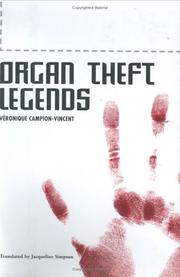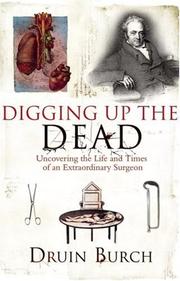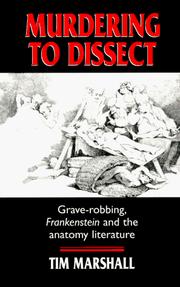| Listing 1 - 10 of 11 | << page >> |
Sort by
|
Book
Year: 1932 Publisher: London : A Ouseley,
Abstract | Keywords | Export | Availability | Bookmark
 Loading...
Loading...Choose an application
- Reference Manager
- EndNote
- RefWorks (Direct export to RefWorks)

ISBN: 1578065933 9781578065936 Year: 2005 Publisher: Jackson: University press of Mississippi,
Abstract | Keywords | Export | Availability | Bookmark
 Loading...
Loading...Choose an application
- Reference Manager
- EndNote
- RefWorks (Direct export to RefWorks)
"In 1987 horrific tales of organ theft that had been circulating in Central and South America for years caught the attention of the international media. Soon reports came from all over the planet, rising to a crescendo in the late 1990s." "Veronique Campion-Vincent describes these narratives in detail and classifies them as three basic types: the Baby Parts Story, Eye Thieves, and Kidney Heists. She then recounts the social problems that seemed to make these awful legends plausible - trade in human organs bought from the living poor; advances in modern medicine which seemed to blur the lines between life and death; the ills of poverty in the developing world and its consequences; and human trafficking." "Religious and moral authorities, political campaigners, propagandists, and the media all exploited the legends of organ theft according to their specific agendas. Campion-Vincent reviews the explanations offered by authorities, reporters, and anthropologists and offers her own folklore analysis pointing out the similarities between organ theft story and the perennial tale of the Slaughter of the Innocents. Noting the real trials of everyday life in much of the Third World and documented cases of illegal trafficking in organs, corpses, and children, Campion-Vincent does not dismiss these tales as just another example of urban legends run amok. Instead, she offers a nuanced analysis of the connections between traditional horror tales, modern trends, and real events to show how complicated it can be to know the truth of any particular story." "These legends still circulate, and variations remain commonplace throughout the world. Campion-Vincent notes, sadly, that the social problems that paralleled the rise of organ theft narratives persist today."--BOOK JACKET
Organs (Anatomy) --- Theft --- Body snatching
Book
Abstract | Keywords | Export | Availability | Bookmark
 Loading...
Loading...Choose an application
- Reference Manager
- EndNote
- RefWorks (Direct export to RefWorks)
Archaeological thefts --- Body snatching --- Grave robbing --- History

ISBN: 9780701179854 Year: 2007 Publisher: London Chatto & Windus
Abstract | Keywords | Export | Availability | Bookmark
 Loading...
Loading...Choose an application
- Reference Manager
- EndNote
- RefWorks (Direct export to RefWorks)
Body snatching --- Human dissection --- Surgeons --- History --- Cooper, Astley, --- Cooper, Astley
Book
ISBN: 9780228019091 9780228019084 0228019095 0228019087 Year: 2023 Publisher: Montréal McGill-Queen's University Press
Abstract | Keywords | Export | Availability | Bookmark
 Loading...
Loading...Choose an application
- Reference Manager
- EndNote
- RefWorks (Direct export to RefWorks)
« Pourquoi des étudiants en médecine ont-ils enlevé des cadavres dans les lieux de sépulture durant près de six décennies (c. 1820-1883) au Québec ? Cette science nécessaire fait la lumière sur une histoire originale et méconnue, en nous plongeant dans l'univers macabre des étudiants en médecine du XIXe siècle. On y croise religieuses hospitalières, chiens protégeant les tombes, juges, patients d'institutions psychiatriques, policiers, évêques, ainsi qu'un grand nombre de médecins. Anglophones ou francophones, tous s'animent autour d'une même question : quels morts peut-on disséquer pour apprendre l'anatomie humaine et devenir un médecin compétent ? Écrit dans un style accessible, à partir de sources fascinantes et souvent inédites, Cette science nécessaire montre l'essor de la profession médicale au Québec en expliquant, par exemple, comment une émeute d'étudiants à coups de fémurs transforme la médecine canadienne, comment Trois-Rivières devient une plaque tournante du transport ferroviaire de cadavres, ou encore pourquoi les squelettes fument la pipe sur les images de salles de dissection de l'époque. Le rôle majeur des organisations catholiques et protestantes dans l'enseignement médical au Québec est mis en évidence : Montréal au XIXe siècle devient un environnement médical hybride où coexistent des établissements francophones et anglophones, ayant peu d'équivalents au monde. Cette science nécessaire est une lecture essentielle, tant pour mieux comprendre l'histoire de la formation médicale au Québec et dans le monde, que pour mettre en contexte les débats actuels sur le respect et la dignité dans les pratiques médicales et funéraires. »--
Medical education --- Human dissection --- Medical students --- Body snatching --- History
Book
ISBN: 3525823932 Year: 1978 Volume: 113 Publisher: Göttingen Vandenhoeck und Ruprecht
Abstract | Keywords | Export | Availability | Bookmark
 Loading...
Loading...Choose an application
- Reference Manager
- EndNote
- RefWorks (Direct export to RefWorks)
Body snatching --- History --- -Theft --- -Addresses, essays, lectures --- Conferences - Meetings --- -History --- Theft
Book
ISBN: 9780735242319 0735242313 Year: 2022 Publisher: Toronto : Allen Lane Canada,
Abstract | Keywords | Export | Availability | Bookmark
 Loading...
Loading...Choose an application
- Reference Manager
- EndNote
- RefWorks (Direct export to RefWorks)
"The perception of medical care on the Great War battlefield recalls scenes from the American Civil War fifty years earlier : blood-soaked surgeons hacking off limbs with grim determination as broken men crawled into their dirty operating rooms. This couldn’t be more wrong. Medical care in almost all armies, and especially in the Canadian medical services, was sophisticated and constantly evolving, with vastly more wounded soldiers saved than lost. After the war, the hard lessons learned by civilian doctors who were temporarily in military uniform were brought back to Canada. A new Department of Health created guidelines in the aftermath of the 1918-19 Spanish flu pandemic, which had killed 50,000 Canadians and millions around the world. In a grim irony, the fight to save soldiers’ lives and improve civilian health was furthered by the most destructive war up to that point in human history. But medical advances were not the only thing brought back from Europe : Life Savers and Body Snatchers exposes the shocking story of the exploitation of human body parts during the Great War. Tim Cook has spent over a decade investigating the hidden history of Canadian medical doctors harvesting the body parts of slain Canadian soldiers and transporting their brains, lungs, bones, and other tissue or bones to the Royal College of Surgeons (RCS) in London. At least 1,200 individual Canadian body parts were removed from dead soldiers and sent to London, where they were stored, treated, and some put on display in exhibition galleries at the RCS. After being exhibited there, the body parts were displayed several times in both Montreal and Hamilton in the early 1920s. Life Savers and Body Snatchers will be the definitive medical history of the Canadian forces in the Great War, and a broader look into the medical advances that came from the carnage."--
World War, 1914-1918 --- Body snatching. --- Medicine, Military --- Medical care --- History
Book
ISBN: 0140228624 Year: 1989 Publisher: Harmondsworth Penguin books
Abstract | Keywords | Export | Availability | Bookmark
 Loading...
Loading...Choose an application
- Reference Manager
- EndNote
- RefWorks (Direct export to RefWorks)
Death --- Dissection --- Funeral Rites --- Social Conditions --- Body snatching --- -Dead bodies (Law) --- -Funeral rites and ceremonies --- -Human dissection --- -history --- history --- history --- United Kingdom. --- Great Britain --- Social conditions -
Book
ISBN: 0710209193 Year: 1987 Publisher: London Routledge and Kegan Paul
Abstract | Keywords | Export | Availability | Bookmark
 Loading...
Loading...Choose an application
- Reference Manager
- EndNote
- RefWorks (Direct export to RefWorks)
Death. --- Funeral Rites --- Social Conditions --- Body snatching --- -Dead bodies (Law) --- -Human dissection --- -Anatomy, Practical --- Practical anatomy --- Dissection --- Dead --- Law --- Theft --- Cardiac Death --- Determination of Death --- Near-Death Experience --- Death, Cardiac --- Thanatology --- Fatal Outcome --- history. --- Law and legislation --- Great Britain. --- Great Britain --- Isle of Man --- United Kingdom --- Social conditions --- -Body snatching --- Dead bodies (Law) --- Funeral rites and ceremonies --- Human dissection --- United Kingdom. --- -Death. --- -history. --- Death --- Anatomy, Practical --- Funerals --- Mortuary ceremonies --- Obsequies --- Manners and customs --- Rites and ceremonies --- Burial --- Cremation --- Mourning customs --- history --- Cryomation --- End Of Life --- End-Of-Life

ISBN: 0719045436 Year: 1995 Publisher: Manchester Manchester University Press
Abstract | Keywords | Export | Availability | Bookmark
 Loading...
Loading...Choose an application
- Reference Manager
- EndNote
- RefWorks (Direct export to RefWorks)
Body snatching --- Frankenstein's monster (Fictitious character) --- Frankenstein, Victor (Fictitious character) --- Grave robbing --- Horror tales, English --- Human body in literature. --- Human dissection --- Medicine --- Monsters in literature. --- Murder --- Scientists in literature. --- History --- History and criticism. --- Frankenstein's monster (Fictitious character). --- Frankenstein, Victor (Fictitious character).
| Listing 1 - 10 of 11 | << page >> |
Sort by
|

 Search
Search Feedback
Feedback About
About Help
Help News
News